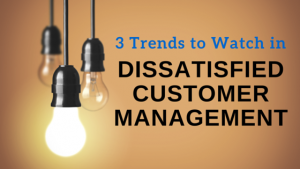2016 is shaping up to be a big year for corporate customer experience (CX) initiatives. In fact, a recent study by CX think tank the Temkin Group affirmed that 84% of surveyed companies said they expect to increase spending on CX measures and metrics this year.
While heightened focus on CX initiatives is important, companies should make sure they prioritize their most vulnerable customer segment—dissatisfied customers. Despite understanding that unhappy customers are quick to defect, many organizations find following up with dissatisfied customers extremely challenging. And today’s technology-savvy customers, who expect immediate responses and consistent treatment from every brand, complicate an already-difficult problem.
There is some good news, however. Advanced CX software offers companies the opportunities to receive real-time notifications every time a customer leaves a negative response. These solutions can also tie negative survey responses directly to the front-line employee responsible for the interaction. As companies adopt such closed-loop alerting (CLA) technology, they can marry it with the right processes to address customer concerns swiftly, while improving performance of their customer-facing teams.
What’s Next in Closed-Loop Alerting
CLA technology is evolving rapidly to empower companies to react in a timely, effective way to negative customer feedback. In the near feature, advanced CLA solutions will include three emerging, value-added features.
Trend #1: Triggering Alerts Based on Verbatim Feedback
Historically, CLA solutions have only tapped into quantitative survey data. The reason? It’s much easier to understand if a customer left a low score in a closed-ended survey format, such as a number scale.
However, customers may leave adequate scores in a closed-ended survey, but articulate their difficult feelings in an open-ended question. Emerging technologies can scan voice of the customer (VoC) feedback for key words or phrases that signal potential customer dissatisfaction and then automatically trigger alerts for analysis and follow-up.
Trend #2: Using Multiple Alert Distribution Methods
At present, email is the medium of choice for sending alert notifications to CX stakeholders. Unfortunately, this creates some risk of important customer alerts being lost in crowded inboxes.
To combat this problem, CX solutions are evolving to include multiple distribution options—including short-messaging service (SMS). Since texting is proving to be a very strong call-to-action (CTA)—with text open rates surpassing 99— SMS could displace email as the top alert distribution method.
In the near future, alerts can better reach distributed teams and make customer follow-up less time-consuming. This is a clear win-win for businesses and their customers.
Trend #3: Distributing Alerts to Multiple Stakeholders
Today’s CX leaders have empowered front-line managers to resolve customer issues within their own teams. With this approach, managers can deepen their customer understanding, while using customer feedback to deliver targeted coaching to their employees.
While this process works well in many scenarios, it has limitations. At times, a front-line manager is not the right person to address a customer concern and needs to engage other experts within the service chain. This creates complexity. Uncoordinated follow-up by multiple parties can make an already-upset customer even more frustrated.
However, new CLA functionality will give companies more control of alert distribution. Organizations can disseminate alerts to more than one individual or team, and track customer outreach attempts in a centralized location. In addition, managers will gain capability to reassign alerts to others, while retaining oversight of alerts until final close out.
Companies Need Future-Ready Dissatisfied Customer Management
Today’s demanding customers expect around-the-clock service and personalized attention. And customers know they have access to an unlimited supply of information about competing brands and more choice than ever before. A single customer experience misstep can cause a customer to defect and to spread negative perceptions online and by word-of-mouth.
For businesses, this unprecedented customer empowerment means that delivering exceptional customer experiences—across every interaction—is an imperative. But organizations should know that mistakes will happen. Having a solid CLA approach provides important back up for the inevitable customer issues that will arise.
Emerging CLA technologies are keeping pace with the needs of customer-obsessed organizations—by distributing alerts to multiple stakeholders by SMS and email. These technologies are also tapping into high-value VoC feedback to provide actionable insight. As companies pursue their 2016 CX initiatives, advancing CLA should be a key item on their to-do list.
****
Republished with author’s permission from original post.
Header background image acquired from Shutterstock.




